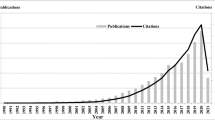Abstract
The United Nations 2030 Agenda for Sustainable Development calls for urgent actions to reduce global biodiversity loss. Here, we synthesize >44,000 articles published in the past decade to assess the research focus on global drivers of loss. Relative research efforts on different drivers are not well aligned with their assessed impact, and multiple driver interactions are hardly considered. Research on drivers of biodiversity loss needs urgent realignment to match predicted severity and inform policy goals.


Similar content being viewed by others
References
Butchart, S. H. et al. Science 328, 1164–1168 (2010).
Millennium Ecosystem Assessment Ecosystems and Human Well-being: Biodiversity Synthesis (World Resources Institute, Washington DC, 2005).
Decision X/2: The Strategic Plan for Biodiversity 2011–2020 and the Aichi Biodiversity Targets (Convention on Biological Diversity, Nagoya, 2010).
Transforming our World: The 2030 Agenda for Sustainable Development (United Nations General Assembly, 2015).
Duffy, J. E., Godwin, C. M. & Cardinale, B. J. Nature 549, 261–264 (2017).
Sala, O. E. et al. Science 287, 1770–1774 (2000).
Tilman, D. et al. Nature 546, 73–81 (2017).
Tittensor, D. P. et al. Science 346, 241–244 (2014).
James, K. L., Randall, N. P. & Haddaway, N. R. Environ. Evid. 5, 7 (2016).
Veríssimo, D., MacMillan, D. C., Smith, R. J., Crees, J. & Davies, Z. G. Bioscience 64, 625–629 (2014).
IPCC Climate Change 2014: Synthesis Report (eds Core Writing Team, Pachauri, R. K. & Meyer L. A.) (IPCC, 2015).
Bellard, C., Bertelsmeier, C., Leadley, P., Thuiller, W. & Courchamp, F. Ecol. Lett. 15, 365–377 (2012).
Maxwell, S. L., Fuller, R. A., Brooks, T. M. & Watson, J. E. Nature 536, 143–145 (2016).
Pauly, D., Christensen, V., Dalsgaard, J., Froese, R. & Torres, F. Science 279, 860–863 (1998).
Global Biodiversity Outlook 4 — Summary and Conclusions (Secretariat of the Convention on Biological Diversity, Montréal, 2014).
Pereira, H. M. et al. Science 330, 1496–1501 (2010).
Brook, B. W., Sodhi, N. S. & Bradshaw, C. J. Trends Ecol. Evol. 23, 453–460 (2008).
Di Marco, M. et al. Conserv. Biol. 30, 189–195 (2016).
Brown, C. J., Saunders, M. I., Possingham, H. P. & Richardson, A. J. Divers. Distrib. 20, 538–546 (2014).
Carpenter, S. R. et al. Proc. Natl Acad. Sci. USA 106, 1305–1312 (2009).
Webb, T. J. Trends Ecol. Evol. 27, 535–541 (2012).
Approaches of the Preparation of the Post-2020 Global Biodiversity Framework (Convention on Biological Diversity, 2017).
Foley, J. A. et al. Nature 478, 337–342 (2011).
Campbell Systematic Reviews: Protocol Template (The Campbell Collaboration, 2017).
R Development Core Team R: A Language and Environment for Statistical Computing (R Foundation for Statistical Computing, Vienna, 2017).
Gamer, M., Lemon, J., Fellows, I. & Singh, P. Package ‘irr’. Various Coefficients of Interrater Reliability and Agreement (2012).
Acknowledgements
We thank the CSIRO Postdoctoral Fellowships that supported T.M., C.D., D.W.G. and M.D.M. We also thank R. C. Babcock, S. Ferrier, S. Kark and A. J. Richardson for providing critical feedback before submission. G. Stewart, C. Wordley and P. Batáry provided constructive assessments that improved the quality of the work.
Author information
Authors and Affiliations
Contributions
C.D. and T.M. initiated and led the working group. T.M., C.D., F.S., D.W.G., N.K., K.M. and V.G. designed the study. T.M. extracted the data. T.M. and D.W.G. analysed the data. T.M., C.D., F.S., D.W.G., N.K., K.M. and V.G. verified the model outputs. C.D. and T.M. co-wrote the paper. F.S., N.K., K.M., M.D.M. and V.G. significantly contributed to revisions.
Corresponding authors
Ethics declarations
Competing interests
The authors declare no competing interests.
Additional information
Publisher’s note: Springer Nature remains neutral with regard to jurisdictional claims in published maps and institutional affiliations.
Supplementary information
Supplementary Information
Supplementary methods, figures, tables, and references
Rights and permissions
About this article
Cite this article
Mazor, T., Doropoulos, C., Schwarzmueller, F. et al. Global mismatch of policy and research on drivers of biodiversity loss. Nat Ecol Evol 2, 1071–1074 (2018). https://doi.org/10.1038/s41559-018-0563-x
Received:
Accepted:
Published:
Issue Date:
DOI: https://doi.org/10.1038/s41559-018-0563-x
- Springer Nature Limited
This article is cited by
-
Regional impacts of warming on biodiversity and biomass in high latitude stream ecosystems across the Northern Hemisphere
Communications Biology (2024)
-
Caught in the crossfire: biodiversity conservation paradox of sociopolitical conflict
npj Biodiversity (2024)
-
Meta-analysis identifies native priority as a mechanism that supports the restoration of invasion-resistant plant communities
Communications Biology (2023)





